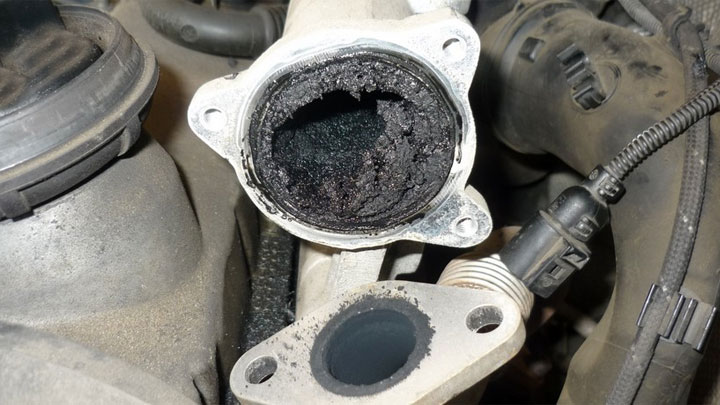P0400 Code (Symptoms, Causes, and How to Fix)
Vehicle issues arise unexpectedly, disrupting busy schedules but diagnostic trouble codes identify problems to simplify repairs. Code P0400 indicates a malfunction in the exhaust gas recirculation system.
If ignored, EGR faults lead to poor drivability, reduced power and increased fuel costs. Let’s look at what a code P0400 means, what causes it, and how to fix it the right way.

What Does Code P0400 Mean?
Diagnostic trouble code P0400 is indicative of a lack of exhaust gas recirculation, as perceived by an engine’s ECM/PCM. Simply put, exhaust gasses are not being redirected into an engine’s intake as anticipated, thus indicating EGR system malfunction.
However, to better understand DTC P0400, one must first familiarize themselves with EGR function as a whole.
Exhaust gas recirculation is a principle of emissions control, placed into practice by virtually all automotive manufacturers. Rather than exhausting all spent combustion gasses straight into the atmosphere, an engine’s EGR system recirculates a certain amount of these gasses through the intake tract for further combustion.
However, the timing of this recirculation is dependent upon a number of factors, most notably including engine temperature. To control this timing, a specialty EGR valve is employed, which opens and closes recirculation passages as commanded by a vehicle’s ECM/PCM.
In the case of DTC P0400, an engine’s operating software has determined that this recirculation is not taking place as intended.
Related: P0401 Code, P0402 Code, P0403 Code, P0404 Code, P0405 Code
Symptoms of Code P0400
Diagnostic trouble code P0400 is often accompanied by several additional symptoms, some of which are more troubling than others. By learning to recognize these symptoms, you should be better equipped to diagnose P0400-related issues as a whole.
The following are several of the most common symptoms associated with diagnostic trouble code P0400.
- Illuminated check engine light
- Increased tailpipe emissions
- Pre-ignition knock or ping
- Reduced fuel economy
Causes of Code P0400

Diagnostic trouble code P0400 can be caused by any number of different underlying factors, which vary in context and overall severity. Understanding these potential causes can prove valuable when attempting to expedite the repair process itself.
The following are several of the most common causes of DTC P0400.
- Clogged EGR passages
- Compromised EGR valve
- Damaged EGR solenoid wiring
- Faulty EGR solenoid
- Substantial vacuum leak
Is Code P0400 Serious?
In general, diagnostic trouble code P0400 is regarded as being relatively serious in nature.
This fault is indicative of a rather serious emissions system issue, which compromises an engine’s ability to recirculate exhaust gasses for further combustion as intended. This presents a couple of concerns, the first of which relates to a vehicle’s inability to pass emissions testing, in states where compliance of this type is mandated.
Additionally, exhaust gas recirculation issues tend to cause noteworthy increases in combustion temperature. This, in turn, can prove detrimental to many of an engine’s internal components, including the engine’s pistons and valvetrain.
If the root cause of P0400 is allowed to persist for extended periods of time, the possibility of internal engine damage is presented.
In any event, the root cause of diagnostic trouble code P0400 should be diagnosed and repaired as soon as possible. This minimizes the risk of secondary issues from arising, as the result of such a condition.
If you don’t feel comfortable tackling such repairs yourself, an appointment should be made with a trusted auto repair shop or dealership at the first available opportunity.
How to Fix Code P0400

The following steps can be used to assist in diagnosing and repairing the root cause of a vehicle’s P0400 fault code. As always, factory-specific service literature for your particular vehicle model should be consulted before tackling any such repairs.
#1 – Check For Additional DTCs
Before beginning the diagnostic process, check for the presence of any additional diagnostic trouble codes. Any such codes should be thoroughly diagnosed and remedied, prior to proceeding.
#2 – Perform Visual Inspection
Begin by carefully inspecting all wiring and connectors included within the EGR circuit. Any damage should be rectified immediately.
Likewise, the condition of all vacuum lines used to actuate vacuum-type EGR valves should be carefully inspected. Any dry-rotting or obvious cracking will necessitate replacement.
#3 – Actuate EGR Valve
You will now actuate your vehicle’s EGR valve, with the engine running, if possible. This can be done on electronically-controlled EGR valves with the use of a bi-directional scan tool. Likewise, many vacuum-controlled EGR valves can be manipulated by hand.
When opening the EGR Valve, listen for a stumble or hesitation within the engine’s idle. If stumbling is evident, intermittent electrical issues are likely to blame for your vehicle’s P0400 fault. Ensure that all connectors are tight, and proceed with a test drive
#4 – Remove EGR, Repeat Testing
If no stumbling was produced in the engine’s idle during step #3, shut off the engine and remove the EGR valve. Repeat the tests above, in an attempt to physically verify the actuation of the EGR valve itself.
If the EGR valve is found to be actuating upon command, clean all intake-mounted EGR passages thoroughly.
#5 – Check For Power/Signal/Ground
If manual testing has uncovered a non-functioning EGR valve, check to see that power and signal voltage is present at the EGR solenoid, as specified by the vehicle’s manufacturer during attempted actuation. Also, check for proper circuit grounding.
Likewise, the presence of sufficient vacuum should be confirmed on vacuum-actuated systems. If all inputs are present, replace the engine’s EGR valve/ EGR solenoid.
If proper input is not supplied to the EGR valve, further diagnostics of the EGR circuit itself will be required, in accordance with manufacturer standards.
- P0480 Code (Symptoms, Causes, and How to Fix) - Apr 19, 2024
- Car Temperature Gauge Stopped Working? (Here’s Why) - Apr 15, 2024
- Ignition Coil vs Coil Pack (What’s the Difference?) - Apr 8, 2024
